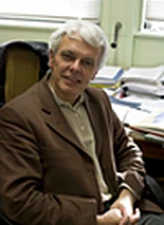Jean Paul Montagner

The 2010 Beno Gutenberg Medal is awarded to Jean Paul Montagner for his influential contributions to the study of seismic anisotropy in the earth’s mantle and for services to global seismology.
Jean-Paul Montagner was born in Vierzon, a small city in the centre of France. After 2 years of preparatory school for «Grandes Ecoles», he entered in 1974 the Ecole Normale Supérieure of Cachan in Theoretical Physics. After a masters in Physics, he succeeded in the national competitive exam «agregation» in basic physical sciences. He then moved to Earth Sciences, and under the supervision of Nelly Jobert at IPG-Paris, he defended a « third cycle thesis» in 1981 devoted to the deep structure of the Pacific ocean. After his recruitment, in 1984, as a researcher at CNRS (Centre National de la Recherche Scientifique), he defended a «state thesis» in 1986 on the study of deep structure of the Earth by inversion of surface waves. During this second thesis, which was undertaken through a collaboration with the CEA (Atomic Energy Commission), he developed the theory of the general effect of seismic anisotropy on surface waves (simultaneously explaining azimuthal and radial anisotropies) and a general tomographic method for seismic anisotropy, which was applied to the 3D-structure of the Indian ocean and the Pacific ocean. He then spent two years at Caltech (1986-1988) as a post-doctoral fellow under the supervision of Prof Don Anderson. He applied his tomographic method to the global scale and published the first global upper mantle shear velocity model that included both radial and azimuthal anisotropy. In recognition of his early career work, he was awarded the bronze medal of CNRS in 1988.
After coming back to France, he obtained the position of Professor of Geophysics at the University Paris-Diderot in 1989. He then continued to work on the inversion of surface wave higher modes with students and on receiver functions with Prof Lev Vinnik of Moscow. With Barbara Romanowicz, he explored the geophysical implications of seismic anisotropy in terms of mantle convection, underlining the predominance of degree 2 and to a lesser extent of degree 6 (related to the hotspot distribution) for velocity and the degree 4 for radial anisotropy. Following the move of Barbara Romanowicz to UC Berkeley, he took over the GEOSCOPE global seismic network, developing its data centre and continuing the development of an ocean bottom broadband observatory. In collaboration with IFREMER (Institut Français de la Recherche en Mer), for the first time the IPG group showed that it was possible to install, operate and recover 2 broadband seismometers on the sea floor and in a borehole close to the mid-Atlantic ridge. At the same time, he worked on the application of seismic anisotropy for mapping continental roots, its relationship with deformation associated with plate tectonics and how it helps to detect plume at depths. Focusing on the Atlantic ocean and on Africa, he showed that there are different families of plumes, some of them originating in the asthenosphere, others in the transition zone. By trying to reconcile anisotropy derived from body waves and surface waves, he made evident the stratification of seismic anisotropy in the upper mantle, reflecting different mechanisms at play. During the last few years his interests have shifted to the application of the time reversal concept for the investigation of seismic and environmental sources (seismic hum, glacial earthquakes). He has written more than 100 peer-reviewed papers and 6 books or chapters of books.
His accomplishments have been recognized through numerous honours: he was appointed member of IUF (Institut Universitaire de France) for 5 years in 1994 and was elected fellow of the AGU in 2004. During several sabbatical stays abroad he was invited as visiting professor, in 1994 to ANU-Canberra, in 2001-2002 to Caltech and to ERI (University of Tokyo) in 2008 and 2009.
He has an impressive record of service at local, national and international levels. He was director of the seismolab at IPGP from 1997 to 2003, consultant at the Ministry of Higher Education and Research from 1991 to 1993, and director of the whole sector of Earth, Universe and Environment Sciences from 2003 to 2006 in the Research Division of the Ministry of Higher Education and Research. This work was devoted to the funding of all labs in this field and to the definition and implementation of national research programs. At the European level, he initiated the training network SPICE and was the leading French representative of this network from 2004 to 2008 and of the training network QUEST starting in 2009. He is also the coordinator of a European Doctoral School in Geosciences (GeoDES) in the framework of the Erasmus Mundus Program in 2009. At the international level, he was chair of the FDSN (Federation of Digital Seismograph Networks) from 1994 to 1998 and vice-chair of ION (International Ocean Network).
He still continues to teach at the University Paris-Diderot, and regularly organizes international meetings (Geoscope, Montessus, ORE,…), workshops and summer schools (Lyon, Cargese, les Houches, …). He trained more than 30 Ph.D. students and supervised more than 10 post-doctoral fellows.
